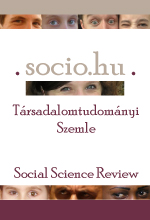Rendszermodellezés a felsőoktatásról
Systems mapping about higher education
Sense-making in a participatory processes
Author(s): Gábor Király, Zsuzsanna Géring, Sára Csillag, Gergely Kováts, Alexandra Köves, Gabriella Sebestyén, Tamás GáspárSubject(s): Social Sciences, Higher Education , Methodology and research technology, Sociology of Education
Published by: MTA TK Szociológiai Intézet
Keywords: higher education; future research; participatory methods; systems modelling
Summary/Abstract: If one attempts to investigate changes and trends in higher education, it is essential to reveal how key stakeholders such as teachers, higher education management staff, and researchers perceive the processes occurring in that sphere and how they make sense of these changes. Sense making is an on-going societal and/or organizational process when people strive to explain their life experience and construe a commonly shared framework of interpretation. The article describes a participatory process in which higher education staff members working ‘in the trenches’ in the field jointly construct a system model for current higher education. The aim of the study is to present the results of the systems mapping and compare them to those published in academic literature on the one hand, and to demonstrate that the technique used may be suitable for analysing sense making processes in organizations on the other hand. The article presents how members of the research panel utilize their internal knowledge and their experience about the workings of the higher education system during the systems-mapping exercise. Revealing this internal point of view is the most interesting, as well as the most important achievement of the process, as this system map provides insights about interpretative frames key stakeholders use in order to make sense of changes in higher education. Therefore, we argue that the results can serve as a useful example for demonstrating how participatory systems mapping could be a useful technique of organizational sense making processes as it allows the participating actors’ perceptions, interpretations, and narratives to be unravelled and arranged in a single logical system.
Journal: Socio.hu Társadalomtudományi Szemle
- Issue Year: 6/2016
- Issue No: 3
- Page Range: 66-90
- Page Count: 25
- Language: Hungarian

